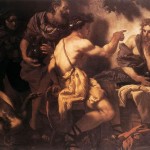I’ve decided to celebrate “throwback Thursday” in my own unique way by re-posting some of my old work, and possibly commenting on how my views have changed (if they have). Originally posted in the Pantheon blog May 14, 2010.
I said I was going to. The trouble is…well, you’ll see.
A few facts to confuse the issue: Feri, also known as Faery, (NOT Fairy Wicca, fairy faith, or Radical Faeries, though we are perfectly willing to go to their parties) was founded in its current form by Victor Anderson; he in turn was taught, according to him, by a group of people known as the Harpy Coven, who were a group of economic refugees from Tennessee and Kentucky who moved to Oregon during the Depression. Feri is mentioned in passing in Ronald Hutton’s The Triumph of the Moon as a “home-grown American strain of religious witchcraft.” That’s true enough; Feri is most strongly rooted in American folk magic, specifically Southern rootwork and conjure. It is not a Gardnerian offshoot, though it acquired quite a bit of Wiccan influence a couple of decades ago and also picked up influences based on Victor’s interests which ranged from Huna to Vodou and beyond. Victor’s wife Cora, who grew up in north Alabama, introduced another strain of Southern influence from her family’s faith healing. The way Victor tended to work early on as described to me by Steve Hewell includes features typical of conjure: very little ceremony, a permanent altar before which “work” was done, using the term “smoking” rather than censing or smudging, use of bath and candle rituals lasting seven or nine days, and so on. Feri does have initiatory lineages similar to Wicca or Sufism, and my particular line emphasizes the Southern folk magic elements of the tradition.
Feri can look rather Wiccany from a distance but the closer you get the less certain you are likely to be of anything, much less what manner of creatures we are. (We don’t call it “Faery” for nothin’.) One major difference is that there is only one initiation in Feri, not a series of degrees; another is that we are not so fond of the male-female polarity model. Our notion of the driving force of the universe is ecstatic and erotic, but mutable, and our Gods are often androgynous. There are also a variable number of them; you could say that Feri is monotheistic, septitheistic, triskaidekatheistic, pantheistic, panentheistic, or infinitely polytheistic. Or all of them at once. We are not so much eclectic as syncretic, but if you are the kind of person who likes definite order in your theology, or for your towels to match, this is possibly not the tradition for you. Solitary practice is the norm rather than the exception, and practice tends to revolve around a set of core meditations and concepts as well as (sometimes instead of) ritual. Feri is also rather diverse; practices which are important to some lines don’t appear in others, and anything anyone says about the tradition, including me, should be taken with a grain of salt and a shot of whiskey.
The one definite thing you can say about us is that we have a lot of creative types…writers, dancers, musicians, artists of all stripes. Aside from Victor himself, creative Feri types you may have heard of include: Starhawk, Gwydion Pendderwen, T. Thorn Coyle, and Sharon Knight. Those are just the most well- known ones; you can hardly swing a cat among a bunch of Feris without whacking someone in communion with their Muse. Not surprisingly, we have some of the most beautiful and moving liturgy around, and an ever-growing body of ritual poetry and music. I think the creative fire we seem to share is both cause and effect, but why I think so must wait on further posts.












